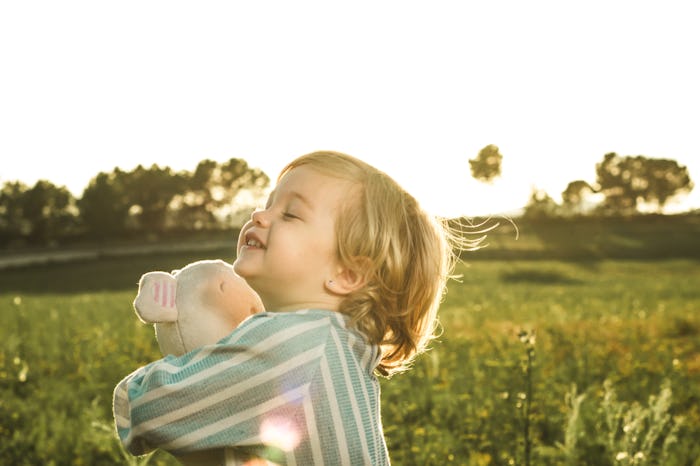Life

How Many Loveys Is Too Many Loveys? You Might Be Surprised By The Answer
In my three-year-old daughter's bed lies a cloth baby doll with yarn hair that used to be yellow but is currently a dingy shade of greige from being dragged across the floor and manhandled by sticky toddler fingers. Still, this little lovey (I'll call her "Lucy" to protect the innocent) isn't even my daughter's favorite. Lucy is only one in a roster of stuffed bears, bunnies, and a bright red Valentine's Day dog. My daughter loves of all them fiercely. But how many loveys can my child have before I need to worry she's too attached to them?
A lovey, also called a comfort object or transitional object, according to Fatherly, is often a stuffed toy that helps ease a child's anxiety as they become independent from their parents. While most parents are no stranger to a toddler's need for one comfort object, a sprawling collection of them might not spark joy in mom and dad's hearts.
Charlotte Reznick, Ph.D., psychologist and author of The Power of Your Child's Imagination, tells Romper that determining how much is "too much" depends on the parents' tolerance level. Quite simply: No set number exists.
"There are too many loveys when [parents] think there are too many loveys," she says. A large amount of transitional objects doesn't necessarily indicate a problem because children associate more loveys with, well, more love and comfort, and that is not a negative thing, Dr. Reznick adds. Parents might be surprised to learn that it's in their little one's best interest to have a rotating roster of loveys, because "[we] don’t want to send the message to a child that only one thing is going to make them feel safe and secure,” Calgary-based child psychologist Cheryl Gilbert-MacLeod told Today's Parent.
If there are no daily issues stemming from the collection, parents should hold off on trying to "wean" their children from their loveys, as "[t]here is no need to urge the child to give it up — they will gradually give up their lovey when they are ready to," Paul C. Holinger, M.D. wrote in Psychology Today. Sometimes kids will incorporate their loveys into their routines, like kissing each one before bedtime. Small, time-consuming habits with loveys may be harmless but annoying if a child has an exceptionally large amount of comfort objects (say, 50 of them), says Dr. Reznick.
If parents are struggling with their child's accumulation of stuffed toys, they can always try winnowing the herd through a lesson about donation to others. "When you get to a point where you say 'Enough,' when she's a little bit older, before she gets another lovey, you could say, 'We could do this as long we donate one of your loveys to someone who needs one," she suggests. Opportunities like these give kids a chance to learn about generosity and reevaluate how important their transitional object is to them at their current stage.
Ultimately, parents don't have to worry that more loveys mean their child has a problem. While we can certainly curtail the number of soft squishies taking up space in our homes, we can also feel free to allow our kids to use them to foster their confidence in unfamiliar settings or experiences.
"It's all about your child feeling safe and comfortable in different situations," Dr. Reznick tells Romper. And once children feel secure enough in themselves, they will not need as many loveys as much, even if they always hold a little space in their hearts — and their beds — for their beloved stuffed animals.
This article was originally published on